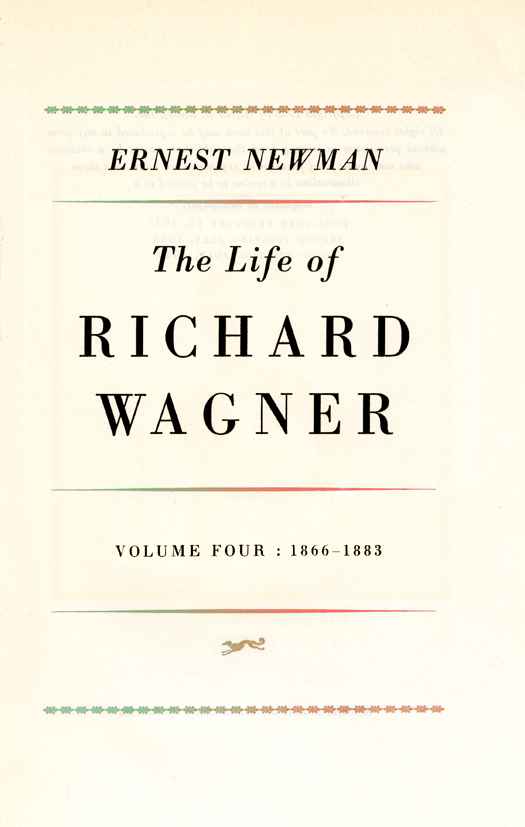Copyright 1946 by Alfred A. Knopf, Inc.
All rights reserved. No part of this book may be reproduced in any form without permission in writing from the publisher, except by a reviewer who may quote brief passages or reproduce not more than three illustrations in a review to be printed in a magazine or newspaper.
eBook ISBN: 978-0-8041-5238-9
v3.1
W AGNER : T HE L AST P HOTOGRAPH
THE LIFE OF RICHARD WAGNER
FOREWORD
T HIS FINAL volume of the Life of Wagner has taken me longer than I had anticipated: I can only plead in extenuation that the past four years of war have not been exactly ideal for sustained intellectual work.
The severance of communications with the Continent since 1939 has perhaps meant my missing some new material, though I hardly think that much of first-rate significance will have come to light during that time. No Life of Wagner, of course, can be considered as anything like final until Wahnfried has opened many more of its treasures to our examination; it is probable, indeed, that more than one of our present facts and judgments will call for correction or modification when certain eagerly awaited documents, such as Cosimas diaries, Wagners Red Book and Annals and Brown Book, and the correspondence of Wagner and Cosima, are published in full, when certain letters to and from Liszt, Blow, Cornelius and others are released from quarantine, and when a number of passages that have obviously been suppressed in letters already published have been restored.
Errors in my earlier volumes there are bound to be; no work on this scale that has occupied an author for many years can possibly be free of them. I have derived some consolation in this connection from the study of the five volumes of Wagner-Ludwig documents issued in recent years by Dr. Otto Strobel, the archivist of Wahnfried. Dr. Strobel is by far the ablest, the best-informed, and the most conscientious of the long line of Wagnerian editors; yet his later volumes contain several self-corrections, further corrections, and even corrections of previous corrections. All in all, however, I feel I can plead, as Sydney Smith once did, that if I have sometimes blundered it was not in consequence of neglect but in spite of attention. Feci quod potui; faciant majora potentes.
The reader may perhaps be surprised at the amount of space allotted to Nietzsche in this volume. I had been accumulating for many years material for a book on Nietzsche. But I had become increasingly conscious latterly that even if I could ever find time to write that book which is unlikely my interest in it had faded; so I decided to incorporate in the present volume most of the material I had collected bearing on the relations of Nietzsche and Wagner. After all, Wagner-biography and Nietzsche-biography will for ever be inseparable. So far the subject of the personal relations of the two men has been superficially treated because it was no ones province in particular to go into it minutely: the Nietzscheans, inheriting their idols hatred of Wagner, were too glad of any stick to beat the latter with to question the truth of some of the statements of the philosopher and his sister, while the Wagnerians with no particular interest in Nietzsche merely turned with a contemptuous shrug of the shoulders from the stupidities and vulgarities of Der Fall Wagner and dismissed that brochure and its author from their minds. What we may call the Nietzsche-Wagner legend has consequently had a long and almost unchallenged run.
That it is largely a legend I have tried to show in the present book, a legend deliberately imposed on the world by Elisabeth Frster-Nietzsche, who took it over from her brothers talk and from Ecce Homo. Nearly forty years ago Bernouilli and others drew on themselves the enmity of the Nietzscheans by their frank criticism not only of Elisabeths lack of intellectual qualifications for the task she had assumed but of the way she went about it. Later research leads us to the conclusion that they under- rather than over-stated the case against her. My own conviction, after long and intensive work at the much-admired Life of Nietzsche, is that it is one of the major impostures of literary biography.
In these pages, of course, I am not concerned with Nietzsches philosophy as such. My concern has been purely and simply with Nietzsche-Wagner biography at the points where the orbits of the two men crossed to find out just what happened, and why. For some of the plain facts of the affair have obviously been falsified by Elisabeth, while her interpretations of them, merely taken over as they were from her brother in the last poisoned years of his sane life, are not to be accepted as blindly as they have hitherto been at their face value. The world is familiar with Nietzsches jibe at official Wagner-biography it was fable convenue, or worse, he said. But that description applies equally well to official Nietzsche-biography; it is high time, indeed, that Elisabeths work went the way of those of Glasenapp and Chamberlain on Wagner and that of Lina Ramann on Liszt, to be replaced by something more objective in its presentation of the facts and more scrupulous in its purpose and methods.
E. N.
Tadworth, January 1945.
THE LIFE OF RICHARD WAGNER
CONTENTS
THE LIFE OF RICHARD WAGNER
ILLUSTRATIONS
W AGNER AT P ALERMO , J ANUARY 15, 1882
pencil drawing by Renoir
THE LIFE OF RICHARD WAGNER
ADDITIONAL SOURCES AND REFERENCES
English translations exist of the works marked with an asterisk.
| A |
ANVP | = C HARLES A NDLER : Nietzsche, sa vie et sa pense. 6 vols. Paris, 1920 ff. |
| B |
BON | = C. A. B ERNOUILLI : Franz Overbeck und Friedrich Nietzsche: eine Freundschaft. 2 vols. Jena, 1908. |
BWG | = L OUIS B ARTHOU : Richard Wagner et Judith Gautier, documents indits. (In Revue de Paris, 1 and 15 August, 1932). |














